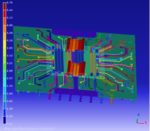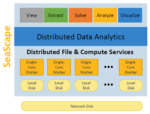Semiconductor manufacturers are under constantly increasing and intense pressure to accelerate innovative new chip designs to market faster than ever in smaller package sizes while assuring signal integrity and reducing power consumption. Three-dimensional integrated circuits (3D-ICs) promise to answer all these demands… Read More
A Different Perspective: Ansys’ View on the Central Issues Driving EDA Today
For the past few decades, System-on-Chip (SoC) has been the gold standard for optimizing the performance and cost of electronic systems. Pulling together practically all of a smartphone’s digital and analog capabilities into a monolithic chip, the mobile application processor serves as a near-perfect example of an SoC. But… Read More
Unlock first-time-right complex photonic integrated circuits
The capacity and energy efficiency challenges from the growing appetite for high-speed data along with advanced applications such as LIDAR and quantum computing are driving demand for increasingly large-scale photonic integrated circuits (PIC). With an ever-increasing number of components on a single photonic chip, manual… Read More
Take a Leap of Certainty at DAC 2022
The live events I have attended thus far this year have been very good. As much as I liked the virtual events, attending in the comfort of my home or sailboat, it is great to be live and networking inside the semiconductor ecosystem, absolutely.
Ansys has been a great supporter of the Design Automation Conference but this year they … Read More
Bespoke Silicon is Coming, Absolutely!
It was nice to be at a live conference again. DesignCon was held at the Santa Clara Convention Center, my favorite location, which to me there was a back to normal crowd. The sessions I attended were full and the show floor was busy. Masks and vaccinations were not required, maybe that was it. Or there was a pent-up demand to get back engaged… Read More
Webinar Series: Learn the Foundation of Computational Electromagnetics
The electromagnetism problems upon which we spent many hours laboring away on homework in college has a mathematical formulation originally developed by Maxwell, Lorentz, Gauss, Faraday and others. In their full forms, these formulas are partial differential equations that come in many versions – both differential and integral.… Read More
5G and Aircraft Safety: Simulation is Key to Ensuring Passenger Safety – Part 4
In our previous blog installments, we examined the ingredient for modeling the potential for interference between a 5G C-band base station and an aviation radar altimeter. Using candidate emissions models for the transmitter, wideband susceptibility models for a candidate radar altimeter receiver and antenna and propagation… Read More
5G and Aircraft Safety: Simulation is Key to Ensuring Passenger Safety – Part 3
In our previous blog installment, we introduced the components of RF interference modeling, and established models for wideband peak emissions of a 5G C-band transmitter and the wideband receiver susceptibility for a radar altimeter receiver. Here, we consider the third component: the wireless channel, which considers the… Read More
5G and Aircraft Safety: Simulation is Key to Ensuring Passenger Safety – Part 2
In our first blog installment, we outlined the interference concerns surrounding the coexistence of the new C-band 5G telecom service spanning the band from 3.7 to 3.98 GHz with aviation radar altimeters. Radar altimeters are essential components for safety during landing and takeoff, as they offer precise measurements from… Read More
5G and Aircraft Safety: Simulation is Key to Ensuring Passenger Safety
The new 5G C-band service is now up and running in the U.S., and subscribers are finally starting to see some of the promise of 5G. The new C-band services are primarily in spectrum allocations between 3 and 4 GHz, providing the wider channel allocation bandwidths necessary to deliver significantly higher data throughput. At the… Read More









